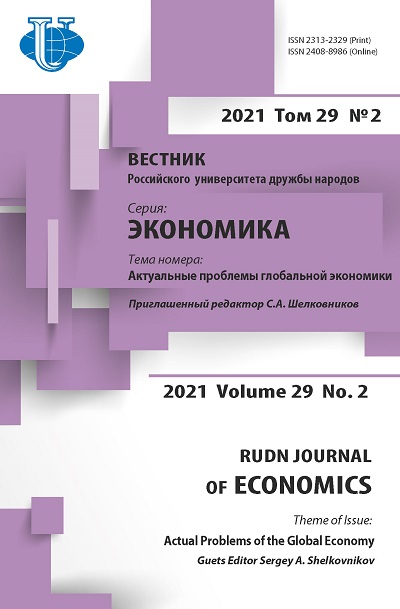Methodological approaches to the development of investment activities of a professional sports organization
- Authors: Matviyenka A.I.1
-
Affiliations:
- Polotsk State University
- Issue: Vol 29, No 2 (2021): ACTUAL PROBLEMS OF THE GLOBAL ECONOMY
- Pages: 299-311
- Section: Industrial organization markets
- URL: https://journals.rudn.ru/economics/article/view/26891
- DOI: https://doi.org/10.22363/2313-2329-2021-29-2-299-311
Cite item
Full Text
Abstract
The article discusses ways to improve the investment regulation of professional sports organizations. The approaches of scientists and researchers in the world economic thought to the problem under study are considered. The effectiveness of professional sports as a type of economic activity in the structure of the national economy of the Republic of Belarus is noted. Based on the assessment of the economic efficiency of the functioning of professional sports organizations in the Republic of Belarus, the analysis of normative legal acts and effective foreign experience, a method of effective regulation of investments in the development of a professional sports organization is proposed, which includes a model of investment regulation and methodological recommendations for maximizing income. In contrast to the existing practice, a holistic system has lined that takes into account the management, marketing, export, information technology, innovation and investment potentials of a professional sports organization. The carried out tested developed methodology for optimize the investment regulation of a professional sports organization on the subject for compliance with real market conditions on the example of the football club of the highest League of the Republic of Belarus “Shakhtyor” (Soligorsk), the results showed a positive economic effect of organization and revealed directions for the development of its supporting segments.
About the authors
Aliaksandr I. Matviyenka
Polotsk State University
Author for correspondence.
Email: alexsandr.psu@mail.ru
senior lecturer, Department of Economics
29 Blokhina St, Novopolotsk, 211440, Republic of BelarusReferences
- Andrikopoulos, A., & Kaimenakis, N. (2009). Introducing FOrNeX: A composite index for the intangible resources of the football club. International Journal of Sport Management and Marketing, 5(3), 251-266.
- Barros, C.P. (2006). Portuguese Football. Journal of Sports Economics, 7(1), 96-104.
- Barros, C.P., & Leach, S. (2006). Analyzing the performance of the English F.A. Premier League with an econometric frontier model. Journal of Sports Economics, 7(4), 391-407.
- Budzinski, O. (2012). The institutional framework for doing sports business: Principles of EU competition policy in sports markets. International Journal of Sport Management and Marketing, 11(1/2), 44-72.
- Buraimo, B., Simmons, R., & Szymanski, S. (2006). English Football. Journal of Sports Economics, 7(1), 29-46.
- Chang, S., & Canode, Sh. (2002). Economic impact of a future college football program. Journal of Sport Management, 16(3), 239-246.
- Cousens, L., & Slack, T. (2005). Research and reviews field-level change: The case of North American major league professional sport. Journal of Sport Management, 19(1), 13-42.
- Cousens, L., Barnes, M., & MacLean, J. (2012). Strategies to increase sport participation in Canada: The role of a coordinated network. International Journal of Sport Management and Marketing, 12(3/4), 198-216.
- Gladden, J.M., Milne, G.R., & Sutton, W.A. (1998) A conceptual framework for assessing brand equity in division I college athletics. Journal of Sport Management, 12(1), 1-19.
- Goshunova, A.V. (2014). Accounting for human capital investments in professional sports organizations (Dissertation of the Candidate of Economic Sciences). Kazan. (In Russ.)
- Haggerty, T.R. (1988). Designing control and information systems in sport organizations: A cybernetic perspective. Journal of Sport Management, 2(1), 53-63
- Koski, P. (1995). Beyond North America organizational effectiveness of Finnish sports clubs. Journal of Sport Management, 9(1), 85-95
- Kovchegin, I.A. (2010). Financial mechanism and accounting and analytical support for the management of professional sports organizations (abstract of the Dissertation of the Candidate of Economic Sciences). Yoshkar-Ola. (In Russ.)
- Krakel, M. (2007). A note on revenue sharing in sports leagues. Journal of Sports Economics, 8(3), 309-316
- Lago, U., Simmons, R., & Szymanski, S. (2006). The financial crisis in European football: An introduction. Journal of Sports Economics, 7(1), 3-12
- Lukinova, O.V. (2012). Development of the methodical of complex economic analysis of football club activities (abstract of the Dissertation of the Candidate of Economic Sciences). Voronezh. (In Russ.)
- MacLean, J. (2009). Auditing performance management practices: A comparison of Canadian sport organisations. International Journal of Sport Management and Marketing, 5(3), 295-309
- MacLean, J., Cousens, L., & Barnes, M. (2011). Look who's linked to whom: A case study of one community basketball network. Journal of Sport Management, 25(6), 562-575
- Matviyenka, A.I. (2020). Modeling of optimization processes of investment activity of a professional sports organization. RUDN Journal of Economics, 28(4), 797-806. (In Russ.) http://dx.doi.org/10.22363/2313-2329-2020-28-4-797-806
- Maxcy, J.G. (2013). Efficiency and managerial performance in FBS college football: To the employment and succession decisions, which matters the most, coaching or recruiting? Journal of Sports Economics, 14(4), 368-388
- Thibault, L., Slack, T., & Hinings, B. (1993). A framework for the analysis of strategy in nonprofit sport organizations. Journal of Sport Management, 7(1), 25-43















